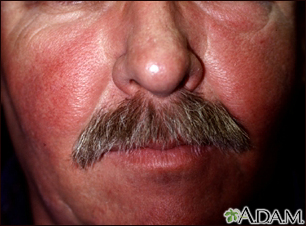Collagen vascular disease
In a class of diseases known as autoimmune disorders, the body's immune system attacks its own tissues. Some of these diseases are similar to each other. They may involve arthritis and inflammation of arteries in the tissues. People who developed these disorders were previously said to have "connective tissue" or "collagen vascular" disease. We now have names for many specific conditions such as:
- Ankylosing spondylitis
- Dermatomyositis
- Polyarteritis nodosa
- Polymyositis
- Psoriatic arthritis
- Rheumatoid arthritis
- Scleroderma
- Systemic lupus erythematosus
- Mixed connective tissue disease
- Relapsing polychondritis
- Vasculitis
When a specific disease cannot be diagnosed, more general terms may be used. These are called undifferentiated systemic rheumatic (connective tissue) diseases or overlap syndromes.

This photograph demonstrates the sign heliotrope eyelids in which the eyelids develop a brown (violaceous - rather than red) color. Heliotrope eyelids and Gottron's papules on the knuckles are characteristic findings in dermatomyositis.

This is a picture of microscopic polyarteritis on the shin. The term polyarteritis means that many blood vessels are inflamed. These nodules are located just below the skin's surface (subcutaneous), are barely felt when pressing on the skin (palpable), and are tender. The skin is typically red (erythematous).

This is a photo of a systemic lupus erythematosis rash on the face. Lupus erythematosis often produces a butterfly rash or malar rash. Typically, the rash also appears on the nose.

The most classic symptom of scleroderma is a type of skin tightening called sclerodactyly. The initial stages of the disease involves swelling of the fingers. Later, as the connective tissue becomes fibrotic, skin on the fingers and toes becomes hard and shiny. The fingers can become difficult to bend and can form contractures due to the severe tightening of the skin.

The affect of rheumatoid arthritis can progress to the degree that it is crippling. Deformities distinctive to late-stage rheumatoid arthritis such as ulnar deviation of the bones of the hands, or swan-neck deviation of the fingers occur because muscles and tendons on one side of the joint may overpower those on the other side, pulling the bones out of alignment.
References
Graf J. Overlap syndromes. In: Firestein GS, Budd RC, Gabriel SE, Koretzky GA, McInnes IB, O'Dell JR, eds. Firestein & Kelley's Textbook of Rheumatology. 11th ed. Philadelphia, PA: Elsevier; 2021:chap 91.
Teegavarapu SP, Mims MP. Lymphocytosis, lymphocytopenia, hypergammaglobulinemia, and hypogammaglobulinemia. In: Hoffman R, Benz EJ, Silberstein LE, et al, eds. Hematology: Basic Principles and Practice. 8th ed. Philadelphia, PA: Elsevier; 2023:chap 50.
Version Info
Last reviewed on: 1/25/2023
Reviewed by: Neil J. Gonter, MD, Assistant Professor of Medicine, Columbia University, NY and private practice specializing in Rheumatology at Rheumatology Associates of North Jersey, Teaneck, NJ. Review provided by VeriMed Healthcare Network. Also reviewed by David C. Dugdale, MD, Medical Director, Brenda Conaway, Editorial Director, and the A.D.A.M. Editorial team.
